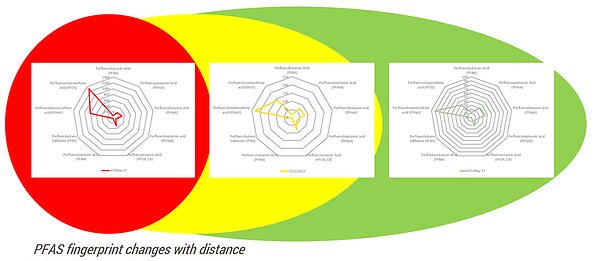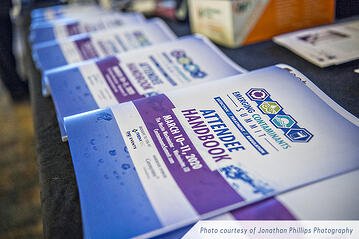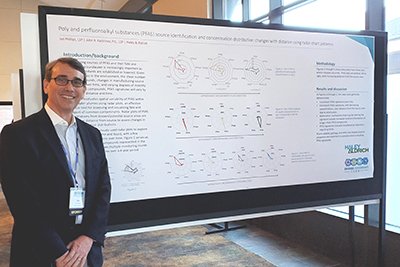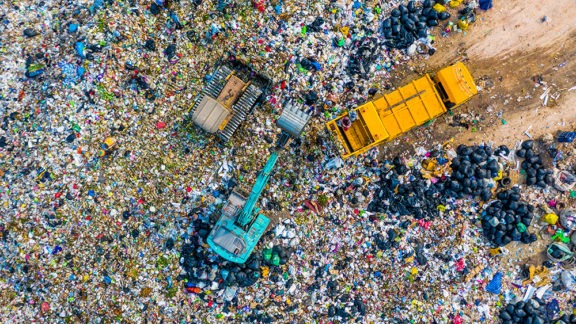The 3rd biennial Emerging Contaminants Summit took place in early March before broad travel restrictions and the enactment of stay-at-home orders due to the COVID-19 pandemic. I attended the summit, along with Haley & Aldrich colleagues Ian Phillips and Sarah Mass. We were impressed with the presentations and discussion on the latest research and developments in the detection, fate and transport, risk assessment, treatment, and regulation of emerging contaminants. Our key takeaways from the conference are summarized below.
1. Ian Phillips of Haley & Aldrich presented on PFAS source identification and concentration distribution changes with distance using radar chart patterns. His poster focused on the stability of dissolved PFAS “fingerprints” over time and distance away from source areas. Such PFAS fingerprints can be used, along with other lines of evidence, to distinguish multiple sources, identify responsible parties, and allocate response costs and liabilities.
Key takeaway: This work will help companies avoid unnecessary costs from additional investigation and remediation.

2. Jim Perlow of ECT2* presented a case study using regenerative ion exchange resin for PFAS groundwater treatment in Australia. ECT2 designed and built the 200 gallon-per-minute pump-and-treat system for a military base, which selected the technology for its ability to effectively treat PFAS and produce much less waste than conventional methods. Using the regenerative resin, the system has treated about 20 million liters of water and only generated 50 liters of waste.
Key takeaway: ECT2’s regenerative system may be a good alternative for treating PFAS in groundwater when compared to conventional treatment technologies.
*ECT2 was a Haley & Aldrich subsidiary until Montrose Environmental Group acquired ECT2 in September 2019.
3. Professor David Freedman of Clemson University delivered a presentation on the development and validation of a new, commercially available tool for assessing in situ biodegradation and natural attenuation of 1,4-dioxane using a 14C assay. Scientists use the heavy isotope 14C for radiocarbon dating in archaeology, geology, and hydrogeology.
Key takeaway: There are very few existing tools for demonstrating the biodegradation and natural attenuation of 1,4-dioxane, making 14C assay a welcome addition to the remediation practitioner’s toolbox.
4. David Adamson of GSI Environmental presented on the results of a study compiling 91,914 separate analytical results of 1,4-dioxane between 2001 and 2018 from a public database of remediation sites. The study revealed an increase in the use of selective ion monitoring (SIM), which contributed to lower reporting limits and higher detection frequencies for 1,4-dioxane. Continued adoption of another method, isotope dilution, will also help lower detection limits.
Key takeaway: You can achieve more accurate results for 1,4-dioxane analysis by combining SIM and isotope dilution.
5. A presentation by Professor Bruce Rittmann of Arizona State University showed that a two-stage process may synergistically remediate 1,4-dioxane, trichloroethylene (TCE), and 1,1,1-trichloroethane (TCA) in groundwater. This process involves an ex-situ treatment technology developed to treat chlorinated VOCs and 1,4-dioxane using two membrane biofilm reactors (MBfR) in sequence. The research team is now developing a plan to demonstrate the technology in the field.
Key takeaway: You will want to keep an eye on this promising new technology, which may prove superior to current remediation methods for treating 1,4-dioxane, TCE, and TCA.
6. Lea Kane of Geosyntec gave a talk about in situ chemical reduction of 1,2,3,-trichloropropane (1,2,3-TCP) using zero-valent zinc (ZVZ) at California’s Camp Pendleton. The site’s maximum 1,2,3-TCP concentration was approximately 10 ppm. Performance monitoring indicates that this remedy sustained 1,2,3-TCP degradation for more than four years.
Key takeaway: There is currently no other effective in situ technology for this contaminant, so this is an exciting new development.

7. Marc Mills of U.S. EPA noted that EPA is developing additional PFAS analytical methods for research and potential use. These methods explore how the contaminant affects surface water, groundwater, soil, and biosolids, fish tissue, and others.
Key takeaway: The only standard method EPA has published to date is for drinking water, but more methods should be coming soon.
8. Professor Selma Mededovic of Clarkson University gave a talk about a field pilot study of ex-situ PFAS groundwater treatment using plasma. In the past, separation technologies such as ion exchange resin or sorption have been the only options for PFAS groundwater treatment.
Key takeaway: Plasma is the first field-demonstrated destructive technology for the PFAS treatment in groundwater.
9. Linda Hall of GSI Environmental gave a presentation titled “Is regulation of PFAS as a class supported by the science?” She concludes that the available science does not support the regulation of PFAS as a class because the compounds known as PFAS collectively vary widely by physico-chemical properties and toxicology. Key takeaway: If governments do not regulate PFAS as a class, but rather individually by compound, the narrower focus could result in less overall liability for companies.
Key takeaway: If governments do not regulate PFAS as a class, but rather individually by compound, the narrower focus could result in less overall liability for companies.
10. A panel of five attorneys discussed the evolution of PFAS litigation and future drivers, noting the increase in PFAS cases in the U.S., with plaintiffs ranging from citizens to states, municipalities, and utility companies. For example, there are more than 500 PFAS-related multidistrict litigation cases pending in the District of South Carolina alone.
Key takeaway: Most of the litigation is related to the contamination of groundwater from aqueous film forming foam (AFFF) near military bases, airports, and other industrial sites.
11. Professor Tim Strathmann of Colorado School of Mines presented on a new PFAS destruction technology by alkaline hydrothermal reaction, using a device similar to a pressure cooker.
Key takeaway: Laboratory testing shows alkaline hydrothermal reaction is effective at degrading PFAS, but it hasn’t been field tested yet.
12. Professor Jens Blotevogel of Colorado State University gave a talk about using nanofiltration and electrochemical oxidation for treating GenX, a short-chain PFAS compound developed to serve as a safer alternative to perfluorooctanoic acid (PFOA). The new process involves a two-step treatment train.
Key takeaway: This potential treatment is encouraging, as there aren’t many effective treatment technologies for GenX besides incineration, which is very expensive.
13. Megan Plumlee of Orange County Water District (OCWD) presented on a PFAS treatment pilot test that OCWD has been conducting. When California regulators lowered the response levels (RLs) of PFOA and perfluorooctane sulfonate (PFOS) in early 2020, it pushed 71 supply wells in the OCWD above the RLs. The OCWD faced annual costs of $50 million to obtain an alternative water supply by importing surface water and decided instead to install a PFAS treatment system for the wells exceeding RLs.
Key takeaway: Over 30 years, capital costs plus operations and maintenance for the new PFAS treatment system will total $850 million, well below the $1.5 billion price of importing surface water.
Published: 5/1/2020
- Aerospace
- Industrial and manufacturing
- Automotive
- Consumer products
- Food and beverage
- Manufacturing
- Contaminated site management
- Emerging contaminants
- PFAS
Author

Principal Consultant, Applied Research Leader




